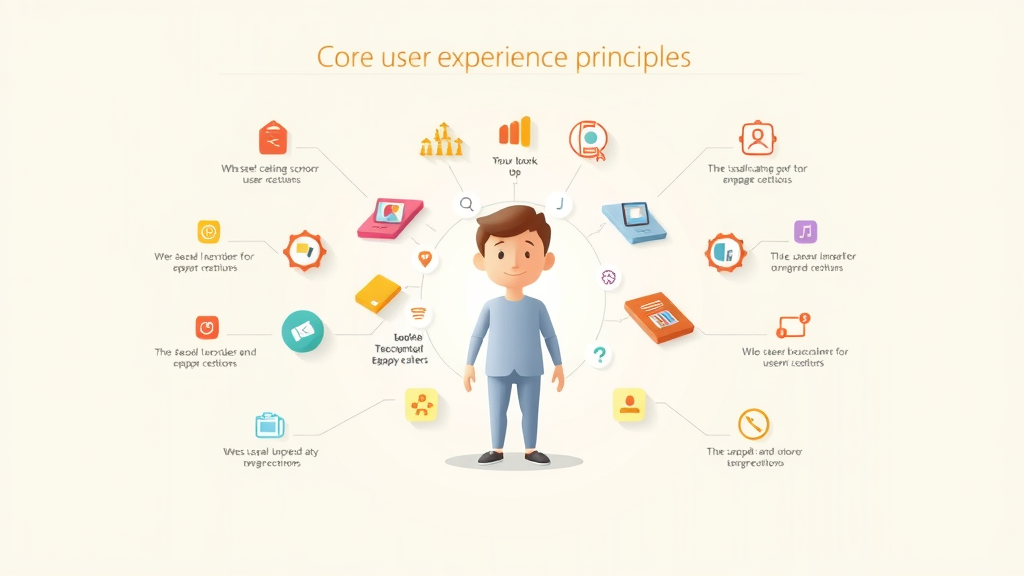
Did you know? Over 80% of customers say a single negative service experience will drive them to a competitor, no matter how great the product itself is. In today’s crowded service landscape, success hinges not just on what you offer, but on how clients feel every step of the way . This guide will show you why user experience for services is your greatest competitive advantage—and exactly how to turn every client touchpoint into a loyalty-building moment.
- You’ll discover how user experience for services can powerfully influence loyalty and revenue.
- Learn the core elements that ensure satisfaction.
- See proven methods for improving service interactions for your clients.
Why User Experience for Services Drives Client Loyalty: An Eye-Opening Statistic
Imagine losing a long-term client over a frustrating phone call or an unclear service process. Studies reveal that nearly 70% of customers cite poor user experience —not price or features—as their top reason for switching service providers. The user experience for services directly impacts every step of the customer journey , from initial inquiry to ongoing support. If you fail to deliver a smooth, intuitive, and emotionally positive interaction, you risk not just a single lost sale, but reduced long-term revenue and a tarnished reputation.
A good UX in services ensures every interaction feels valuable, clear, and respectful of your client's time. Whether it's booking an appointment, resolving an issue, or accessing digital portals, each moment shapes perceptions and loyalty. Companies investing in strategic service design and effective user research are more likely to retain clients and benefit from their positive word-of-mouth.
Understanding User Experience for Services: Definitions and Core Concepts
User experience for services is the sum of all interactions and emotions a customer feels when engaging with a service provider. Unlike one-off transactions with products, services unfold over multiple touchpoints—think conversations with staff, digital app usage, appointment reminders, or aftercare emails. At every stage, clients expect seamless service design , intuitive user interface , and personalized attention. Successful organizations weave together these elements to create loyalty-inspiring journeys.
While traditional UX design principles still apply, they must be innovatively adapted for the fluid and often unpredictable nature of services. Feedback is instantaneous, stakes are high, and direct human interaction plays a major role. That’s why top firms prioritize user-centric thinking in their design process —from mapping pain points to deploying creative digital solutions.
Is User Experience for Services Different from Product UX Design?
Absolutely. While product UX focuses on how users interact with a physical or digital product (like a smartphone or app), user experience for services involves ongoing, multi-channel interactions over time. It’s not a single transaction; it’s about building trust with each touchpoint. Services rely heavily on conversation, timeliness, and adaptability—factors that don’t always apply to tangible products. For example, booking a spa treatment isn't just about using an online form (a product); it’s about confirmation, arrival, staff engagement, and post-visit follow-up (a fluid service experience).
Because services are inherently dynamic, service design incorporates both ux and ui principles, aligning digital and human factors. The goal is to optimize not just the immediate user flow , but the entire continuum from initial contact to continued support.
The Role of the UX Designer in Service Design: Building Consistent Service Pathways
A ux designer working on services must become an orchestrator of experiences rather than just a digital product expert. These professionals analyze every touchpoint where end users interact with the business: online portals, phone systems, face-to-face service, emails, and more. They're not only mapping out the user journey but stitching it together to ensure consistency and satisfaction. Effective ux designers bring empathy to the design process , anticipate pain points , and build solutions that address user needs at every turn.
They often facilitate ux research and collaborate with operations and customer support staff to transform service design concepts into practical, delightful realities. The result? Smoother transitions, clearer instructions, faster problem resolution, and a sense of reliability that earns lasting loyalty.
Aligning Service Design and User Experience to Maximize Customer Experience
Smart companies bridge service design and user experience —not as separate efforts, but as two sides of the same coin. Service design defines the blueprint for how a service operates (processes, resources, people). User experience design then shapes these operational flows into journeys that are simple and rewarding for the client. The intersection is where value is delivered: predictable systems meet user needs, while frontline staff are empowered by strong digital and analog support tools.
Aligning these areas minimizes pain points and wasted effort, ensuring that the customer experience remains smooth, positive, and memorable. The key is continual feedback loops, where user research refines both the service infrastructure and client-facing details.

The 5 Elements of User Experience for Services: Framework and Explanation
Delivering outstanding user experience for services isn’t accidental. It follows a proven five-element framework, ensuring every phase aligns with end-user and business goals. By understanding each layer, organizations can pinpoint strengths and address pain points in both digital experience and face-to-face interactions.
- Strategy – Identify real user needs and balance them with business objectives. This guides every decision and prevents wasted effort on features clients don’t value.
- Scope – Get specific about what the service must deliver. These requirements shape what’s promised to clients and what teams build internally.
- Structure – Organize all information, exchanges, and pathways. Clear flows minimize confusion and help predict what clients need next.
- Skeleton – Design the detailed workings of each interaction, interface, and navigation step. This is where ui design and process clarity come together.
- Surface – Create impactful visual, auditory, and physical touchpoints. This is what clients see, hear, and feel—a brand’s promise made tangible and memorable.
Applying this holistic model to service design leads to less friction, more satisfaction, and higher client retention across both offline and digital experience channels.
| Element | User Experience (UX) | Customer Experience (CX) |
|---|---|---|
| Scope | Specific touchpoints and user actions | End-to-end relationship lifecycle |
| Focus | Usability, clarity, and interaction | Emotions, perceptions, and value |
| Ownership | UX Designers | Service, operations, and marketing teams |
| Measures | Success with tasks, satisfaction with interface | Overall satisfaction, loyalty, advocacy |
| Timeframe | Momentary interactions | Entire duration of relationship |
Overlapping Areas: UX Design, Service Design, and Customer Experience
The boundaries between ux design , service design , and customer experience are becoming delightfully blurred—and that’s by necessity. Delivering a seamless journey means thinking holistically, not in silos. A user experience designer must understand the operational realities of the business, while operational teams must consider the emotions and mental models of the end user .
Experience design teams work closely with product and service managers, tech, and frontline staff to ensure that brilliance on a whiteboard becomes real-world impact. The aim: simplify complex journeys, build universal trust, and transform pain point "roadblocks" into loyalty-driving "wow" moments at every touchpoint—digital or analog.
User Experience for Services and Customer Experience: Where They Intersect
At the heart of both UX and CX lies empathy—the ability to see the world through your client's eyes. While user experience for services zeroes in on usability and interaction quality, the broader customer experience considers price, marketing, brand reputation, and even the emotional aftermath of every contact. The intersection? Both disciplines demand clear communication, ease of use, and genuine care for client success.
Leading organizations drive results by sharing data and feedback between ux researchers and customer support teams. When a client drops off at a confusing interface, their complaint fuels both short-term fixes (UX) and longer-term strategy (CX). This flow of information ensures issues are not just patched—they’re solved at the root, creating an upward spiral of satisfaction.

The Impact of Digital Experience on Modern Service-Based Businesses
Today’s digital experience is a dealbreaker for service brands. Clients expect 24/7 access, personalized action steps, instant responses, and seamless handoffs between online and in-person touchpoints. A poorly designed website, a laggy app, or confusing appointment flows can directly impact revenue and repeat business—no matter how friendly the face behind the desk.
Enhancing digital experience goes beyond flashy visuals. It’s about robust information architecture, thoughtful notifications, intuitive navigation, inclusive design, and lightning-fast resolutions. Service companies that continually iterate on their digital (and hybrid) touchpoints consistently outperform those who treat technology as an afterthought.
"Every interaction is a chance to win or lose a customer — prioritize user experience for services."
User Research: Understanding Client Needs in Service Interactions
You can’t design world-class user experience for services in a vacuum. Instead, user research uncovers what clients value most, where they stumble, and what keeps them coming back. It’s the only way to transition from guesswork to evidence-based decision-making. Organizations that thrive invest in regularly collecting, analyzing, and acting on client feedback at every stage of the journey.
From surveys and interviews to analytics and usability studies, ux research shines a light on hidden pain points and unmet needs. This process fosters innovation by challenging assumptions and surfacing fresh insights that directly inform service design priorities and resource allocation.
Methods of User Research for Service-Based Companies
There is no one-size-fits-all approach to user research in service environments. However, several proven methods empower leaders to deeply understand their end user base:
- Surveys and Questionnaires: Quickly capture broad sentiment and spot trends in satisfaction or confusion.
- In-Depth Interviews: Reveal emotional drivers, contextual challenges, and hidden expectations.
- Journey Mapping Workshops: Visualize the entire customer journey to find gaps and friction points.
- Observation: Shadow real service experiences (both physical and digital) to see what clients do, not just what they say.
- Usability Testing: Ask real users to interact with service interfaces and capture stumbling blocks in real time.
Each technique unearths valuable data for targeted improvements, allowing ux designers to design solutions that resonate at both the strategic and granular levels.
Using UX Research to Inform Service Design Decisions
The goal of ux research is far more than reporting statistics. Instead, it becomes a driver for continuous service design innovation. Analysis of client journeys enables businesses to detect recurring pain points , clarify language, streamline complex procedures, and invest in new touchpoints or technologies that foster loyalty.
For instance, if research shows that clients abandon a digital check-in process due to unclear steps, ux designers can simplify prompts, rewrite instructions, or redesign the interface entirely. The most successful service organizations view research as an ongoing investment—integrating insights into quarterly reviews, training updates, and every phase of their ux design process .
[Video placeholder: "Explainer: How User Research Enhances User Experience for Services"]
The Role of UX Designer in Service Delivery Teams
Within service organizations, the ux designer is both a visionary and an engineer. They advocate for the end user while pragmatically aligning with business realities. As services become more complex—blending digital, physical, and human elements—having a dedicated UX lead is no longer optional. It's a must for brands seeking to differentiate through loyalty and satisfaction.
Unlike traditional product teams, service UX designers coordinate across multiple departments: tech, HR, training, front-line staff, and management. Their success hinges on communication, empathy, and a relentless focus on client-centricity during every stage of the service design lifecycle.
Key Responsibilities of a UX Designer in Service Design Projects
The modern ux designer wears many hats in a service setting. Here’s what the role typically encompasses:
- Mapping User Flows: Diagram how clients move from first contact to loyalty, highlighting obstacles and opportunities.
- Orchestrating User Testing: Design and run studies to validate proposed changes and eliminate pain points .
- Crafting Consistent Branding: Ensure every touchpoint, digital or physical, reflects the organization’s values and messaging.
- Collaborating on Training: Develop scripts, guidelines, and digital resources for front-line teams to ensure a predictable, high-quality experience.
- Iterative Design: Continuously upgrade and fine-tune each service process using findings from user research and analytics.
Their expertise extends beyond visual design—it’s about improving systems, building relationships, and aligning design principles with measurable business goals.

Collaboration Between UX Designers, Service Personnel, and Customer Support
Exceptional user experience for services arises from teams working in concert. UX designers facilitate close collaboration with service personnel and customer support —breaking silos and promoting shared ownership of the customer journey . When an interface update is planned, designers gather frontline input to ensure new screens won’t confuse clients. Similarly, service and support agents share customer feedback with the design team, ensuring quick adaptation to emerging needs.
This dynamic feedback loop enhances trust, reduces errors, and keeps everyone invested in building a more rewarding experience for clients. Ultimately, successful brands reward staff participation in experience design —unlocking new levels of productivity and satisfaction on both sides of the interaction.
Applying Design Principles to User Experience for Services
Great user experience for services is built on timeless design principles that ensure every moment feels intentional, inclusive, and impactful. These foundational values aren’t just theoretical—they guide every workflow redesign, support script update, and digital tool launch, making sure each step in the journey builds trust.
At their core, these principles keep the client front and center, from the first click to the final handshake. By focusing on empathy, clarity, and consistency, service providers can transform even routine transactions into memorable, relationship-building opportunities.
Essential Design Principles That Shape Positive Service Experiences
- Empathy: Understand what users feel at every stage and design interactions that meet their needs compassionately.
- Simplicity: Remove unnecessary steps, jargon, and confusion—making each process as straightforward as possible.
- Consistency: Ensure branding, policies, and responses align across every touchpoint and department.
- Accessibility: Make services usable by people of all abilities, backgrounds, and languages.
- Feedback: Provide timely updates and confirmations, reducing anxiety and building client confidence.
- Efficiency: Respect your client’s time with quick processes, fast answers, and intuitive support.
- Delight: Surprise clients with moments of joy, personalization, or going the extra mile.
By grounding every service design in these essentials, organizations move from merely satisfying to truly inspiring their clients—building advocates who spread the word and come back again and again.
[Video placeholder: "How Service Providers Can Apply UX and UI Principles"]
User Interface Considerations for Service Touchpoints
In the era of omnichannel engagement, user interface decisions aren’t just about aesthetics—they’re a strategic lever for business performance. Customers judge your service quality based on how easy, accessible, and enjoyable your interfaces are—which means ui design is central to user experience for services . The best brands treat their apps, kiosks, websites, and physical environments as unified, not disconnected. Every screen, button, sign, and spoken word counts toward building (or losing) trust.
High-performing teams apply ux and ui best practices for clarity, minimizing steps, and ensuring feedback at every stage. This creates an environment where clients feel empowered, not confused, increasing both usage and loyalty over time.
Physical and Digital User Interface Integration in Services
Clients increasingly expect frictionless transitions between physical and digital spaces. For instance, booking an appointment online, checking in at a kiosk, and then receiving personalized assistance from staff—all use different user interfaces but must feel like a unified journey. Any disconnect—such as incomplete data transfer or inconsistent branding—breaks the illusion and fuels frustration.
Modern service design invests in infrastructure that links physical and digital touchpoints. That means updating digital signage, synchronizing mobile apps, training staff on new tools, and testing every touchpoint for usability. Companies that excel at these integrations remove barriers and foster confidence, ensuring each client feels known, understood, and supported.

Best Practices for Enhancing the Digital Experience in Service Firms
To strengthen digital experience , service organizations should:
- Ensure mobile responsiveness and accessibility for all web-based interactions.
- Use clear navigation cues, feedback messages, and progress indicators to guide clients.
- Personalize information and recommendations based on past service usage.
- Enable real-time support (chatbots/live agents) within digital channels for fast issue resolution.
- Regularly test with real users to uncover new obstacles and optimization opportunities.
With these strategies, user experiences become smooth, enjoyable, and memorable—directly impacting retention and revenue for today’s service-first organizations.
Usability Testing, User Testing, and Continuous Improvement in Services
Consistently stellar user experience for services is never an accident—it’s the result of relentless testing, learning, and iteration. Usability testing and user testing bridge the gap between what designers intended and what clients actually experience. Service businesses that prioritize ongoing discovery quickly identify pain points , reduce drop-off, and uncover unexpected opportunities for improvement.
By integrating these practices into the design process , brands can deliver smoother service flows, reduce client effort, and foster loyalty at scale.
Methods for Conducting Usability Testing in Service Environments
There are multiple approaches to usability testing in services—each offering unique insight:
- Remote/Online Usability Testing: Observing clients as they navigate digital service portals, capturing hesitations and errors.
- In-Person Testing: Watching real clients interact with check-in kiosks, staff, or signage within your physical site to spot confusion or bottlenecks.
- Think-Aloud Protocols: Asking test users to verbalize their thoughts during a live interaction for deeper understanding of intent (and frustration points).
Pairing these with analytics provides both qualitative and quantitative data, empowering teams to continually refine both digital and analog touchpoints.
The Role of User Testing in Refining Service Interfaces
User testing is not just about fixing bugs—it’s a culture of curiosity that powers continuous improvement. By involving real users early and often, organizations surface hidden usability gaps before they can damage client satisfaction. Each round of testing informs interface tweaks (fonts, labels, button placement) as well as broader process overhauls (scheduling, notifications, follow-ups).
Service leaders who embrace user testing build more resilient, adaptable systems—ensuring user experience for services remains a lasting strength, not a temporary advantage.
[Video placeholder: "Practical Demo: Usability Testing in a Service Scenario"]
People Also Ask: What is the user experience of a service?
The user experience of a service refers to how clients perceive and feel about the entire sequence of interactions they have with a service provider, from first contact to post-service support. It encompasses usability, emotional impact, and satisfaction at every touchpoint, driving loyalty and the likelihood to return or recommend.
People Also Ask: What are the 5 elements of user experience?
The five elements are strategy, scope, structure, skeleton, and surface. These represent the process from understanding what users and the business need, organizing content and interaction effectively, down to the final design details that make every service touchpoint memorable.
People Also Ask: What's the difference between UX and CX?
User experience (UX) focuses on a user's specific interaction with a service, while customer experience (CX) covers the holistic journey, including all interactions, perceptions, and emotional responses throughout the relationship with the service provider.
People Also Ask: What are the 7 principles of user experience design?
The seven principles are: Useful, Usable, Findable, Credible, Desirable, Accessible, and Valuable. Applying these principles strengthens user experience for services and builds trust and satisfaction.

Frequently Asked Questions About User Experience for Services
- How do I measure user experience for services? Measure using client satisfaction surveys, Net Promoter Score (NPS), task completion rates, and tracking feedback from both digital and personal touchpoints. Regular usability tests and direct interviews with clients reveal actionable insights to fine-tune your service design continuously.
- What tools are best for improving digital and physical service interfaces? Leading platforms like Hotjar, UserTesting.com, Lookback, and Google Analytics help you analyze user behavior online. For in-person environments, observation, journey mapping workshops, and feedback kiosks provide actionable data to upgrade the physical service experience.
- How does service design integrate into existing customer experience programs? Effective integration starts with cross-functional teams and shared KPIs. Service design provides structure and process clarity, while customer experience strategies address emotional resonance and loyalty. When aligned, both drive powerful results: fewer complaints, more referrals, and deeper client trust.
Ready to Transform Your User Experience for Services? Start Growing Client Loyalty Today
Ready to grow your business? Book your free Marketing Strategy Session at https://imodagency1.com or call 562-620-7576 to learn how next-level user experience for services can unlock unwavering client loyalty and revenue growth.
Enhancing user experience (UX) in service design is pivotal for fostering client loyalty and achieving lasting success. The article “User Experience for Services: The Key to Client Loyalty and Lasting Success” delves into this concept, emphasizing the importance of seamless, intuitive interactions throughout the customer journey.
For a deeper understanding of how UX differs from customer experience (CX) and its impact on client retention, consider exploring IBM’s comprehensive guide, “ What is User Experience (UX)? ” ( ibm.com ). This resource elucidates the distinctions between UX and CX, highlighting how a well-designed UX can lead to increased customer satisfaction, improved retention, and a competitive edge.
Additionally, the article “ 7 Service Design Practices To Improve Your UX Design ” ( designlab.com ) offers practical strategies for integrating service design principles into UX design. It emphasizes the importance of a holistic approach, considering the entire service journey to enhance user satisfaction and loyalty.
By leveraging these resources, you can gain valuable insights into optimizing user experience within service design, ultimately driving client loyalty and business success.
 Add Row
Add Row  Add
Add 




Write A Comment